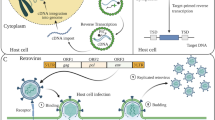Abstract.
The rice retrotransposon Tos17 is highly activated by tissue culture. To evaluate the impact of transposition of Tos17 on the rice genome and examine its utility for insertional mutagenesis, more than 100 sequences flanking newly transposed Tos17 copies were characterised. The 5-bp target-site duplications flanking Tos17 did not show any consensus sequence, and preferred nucleotides, A/T and G/C, were only found at the second and third nucleotides from both ends of the target site duplications, respectively, indicating that Tos17 has relatively low target-site specificity at the nucleotide sequence level. Integration targets were widely distributed over the chromosomes; however, preferential integration into the sucrose synthase 2 gene and into Tos17 itself was demonstrated by PCR screening using pooled DNA prepared from the mutant population. Hybridisation studies indicated that Tos17 preferentially integrates into low-copy-number regions of the genome. In agreement with this result, about 30% of flanking sequences examined showed significant homology to known genes. Taken together, these results show that Tos17 can have a significant impact on the rice genome and can be used as a tool for efficient insertional mutagenesis.
Similar content being viewed by others
Author information
Authors and Affiliations
Additional information
Electronic Publication
Rights and permissions
About this article
Cite this article
Yamazaki, M., Tsugawa, H., Miyao, A. et al. The rice retrotransposon Tos17 prefers low-copy-number sequences as integration targets. Mol Gen Genomics 265, 336–344 (2001). https://doi.org/10.1007/s004380000421
Received:
Accepted:
Published:
Issue Date:
DOI: https://doi.org/10.1007/s004380000421




